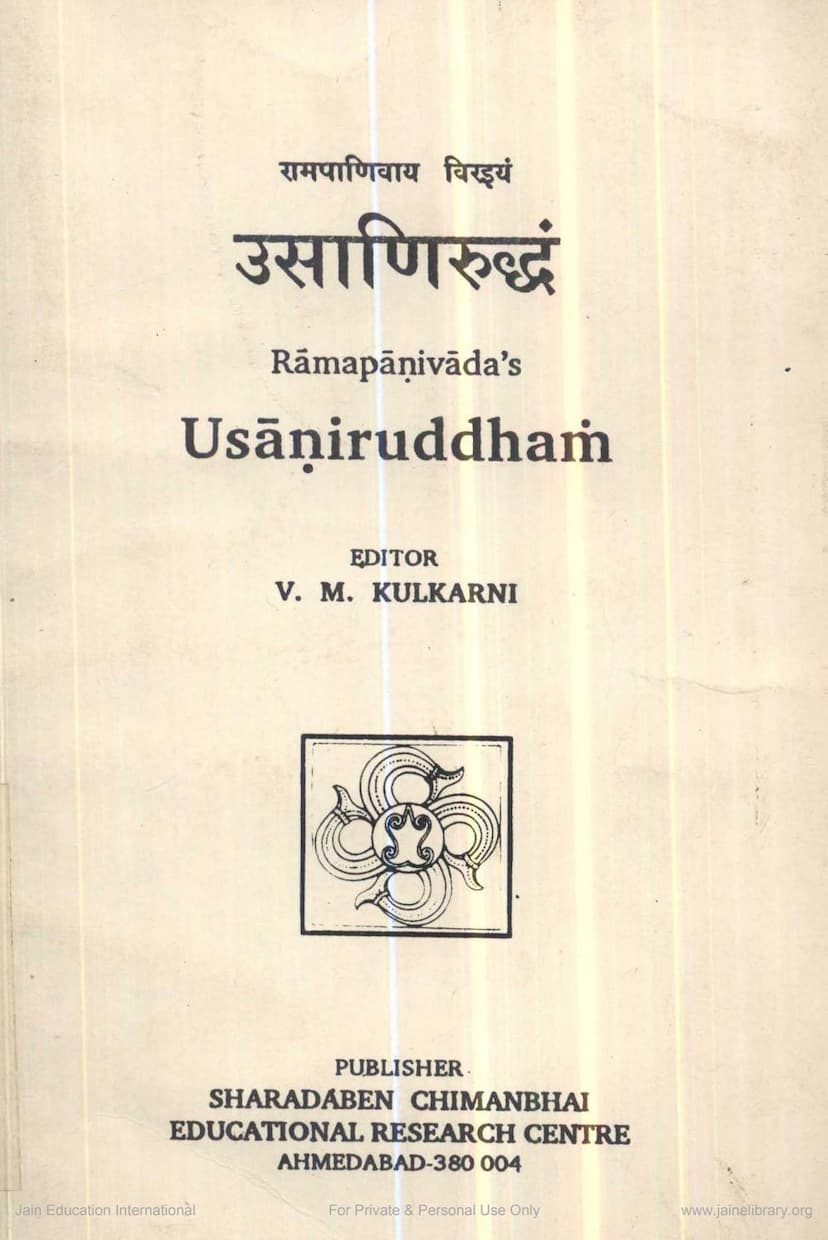Usaniruddham
Added to library: September 2, 2025

Summary
Here's a comprehensive summary of the Jain text "Usaniruddham" by V. M. Kulkarni, based on the provided pages:
Book Title: Usaniruddham Author: Rāmapāņivāda Editor (Second Enlarged Edition): Prof. V. M. Kulkarni Publisher: Sharadaben Chimanbhai Educational Research Centre, Ahmedabad
Overview: "Usaniruddham" is a Prakrit poem that tells the story of the love between Uṣā and Aniruddha, grandson of Lord Kṛṣṇa. The text is presented as a primer for beginners learning the Prakrit language and has been prescribed in university Prakrit departments. This edition, the second enlarged one, is a significant effort to make this text available again after it went out of print.
Key Features and Content:
- Author and Text: The authorship is attributed to Rāmapāṇivāda, who is also believed to have authored the "Kamsavaho." The text is based on a manuscript from the Government Oriental Mss. Library, Madras, and includes a Sanskrit Chāyā (literal translation/explanation) preceding the Prakrit text, which is noted as an interesting or unusual practice. The manuscript is described as corrupt in many places, leading to a detailed "Procedure of Text-Constitution" by the editor.
- Editorial Work: Prof. V. M. Kulkarni, a renowned scholar in Prakrit studies, has meticulously edited the text. His preface details his personal connection to the work and the efforts involved in its re-publication. He expresses gratitude to Prof. H. C. Bhayani and Prof. K. R. Chandra for their guidance. The editor highlights the challenges posed by scribal errors and the need to normalize the Prakrit, using grammatical rules and comparisons with "Kamsavaho."
- Structure: The poem is divided into four Cantos (Sargas). The total number of verses is approximately 280. The text is noted to have some gaps, particularly at the end of the Second Canto, suggesting missing verses.
- Authorship and Age: While the manuscript doesn't explicitly name the author, the attribution to Rāmapāṇivāda is based on the scholarly opinions of M. Krishnamachariar and Mahākavi Ullur S. Paramesvara Aiyar. Similarities in linguistic style, forms, and phrases between "Usaniruddham" and "Kamsavaho" further support this. The poem is considered a late work in Prakrit literature, possibly dating to the mid-18th century AD. Prof. Kulkarni suggests "Usaniruddham" was composed earlier in Rāmapāṇivāda's life, followed by "Kamsavaho" at a more advanced age, based on subjective analysis of their style and content.
- Story Summary:
- Canto I: The poem begins with invocations to Ganesa, Sarasvati, and the divine couple. It introduces the glorification of Vasudeva and recounts the birth and deeds of Krsna. The central narrative focuses on Krsna's grandson, Aniruddha, and his love for Uṣā, daughter of King Bāṇa. Uṣā sees Aniruddha in a dream, and her friend Citralekhā miraculously brings him to her. They engage in love sports, which are discovered by Bāṇa, leading to a battle between Aniruddha and Bāṇa.
- Canto II: Krsna, upon learning of Aniruddha's disappearance from Narada, sets out with his army to rescue him. The army's march is described vividly. Lord Śiva, as Bāņa's ally, engages in battle with Krsna. Various divine missiles are exchanged, and Krsna's strength is highlighted. The narrative describes Śiva's intervention and the subsequent battle between Bāna and Krsna. The introduction of a "Three-headed Fever" demon and Krsna's counter-Fever adds a unique element.
- Canto III: Bāṇa, with his thousand arms, renews the battle against Krsna. His arrogance and claims of power are presented. Krsna cuts off Bāṇa's arms. Śiva intervenes, praising Krsna's divine exploits and incarnations. Bāṇa, humbled, offers his daughter Uṣā in marriage to Aniruddha. The royal families reconcile, and Krsna returns to Dvāravatī with the couple.
- Canto IV: The return of Uṣā and Aniruddha to Dvāravatī is met with great excitement by the townspeople, especially the women who are depicted in humorous and hurried preparations to see the couple. The poem then elaborates on the couple's love, their reflections on the moon, and the various poetic comparisons and similes used to describe their emotions and the celestial body. The canto concludes with Krsna's blessings for happiness and prosperity.
- Source of the Story: The story of Uṣā and Aniruddha is found in Purāṇas like the Bhagavata and Harivamsa. The author primarily follows the Bhagavata.
- Prakrit Language: The text is a significant specimen of Prakrit composition from the later period of its literature. The editor discusses the antecedents of the Prakrit language as used in dramas and its relation to Sanskrit, noting tendencies like vowel confusion, consonant changes, and Sanskritization of forms.
- Metres: The poem employs various metres, including Upajātī, Puspitāgrā, Viyogini (Vaitāliya/Sundarī), Anustubh, and others. The editor notes the absence of the Āryā metre, which was prevalent in earlier Prakrit literature.
- Style: "Usaniruddham" is characterized as an ornate poem (Kāvya). The author aims for an artistic and pleasant narration of events, using natural similes and poetic embellishments. The style is described as generally pithy and simple, with amorous sentiments being predominant. The descriptions of battles and love scenes are noteworthy.
- Notes and Bibliography: The edition includes mythological notes explaining the various deities and figures mentioned, as well as a select bibliography of related works.
Significance: This publication by the Sharadaben Chimanbhai Educational Research Centre is crucial for preserving and disseminating Prakrit literature. It makes a valuable classical poem accessible to students and scholars, contributing to a deeper understanding of Jain and Indian literary traditions. The detailed editorial work by Prof. Kulkarni enhances its academic importance.